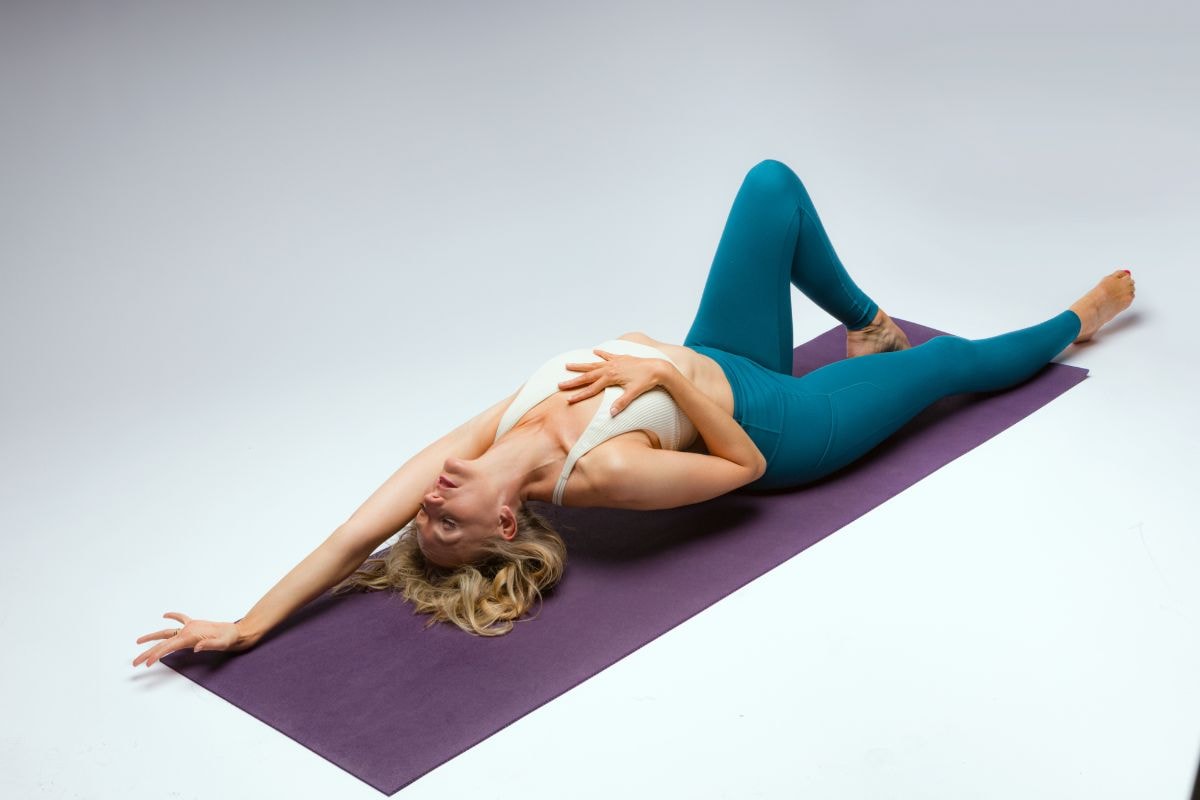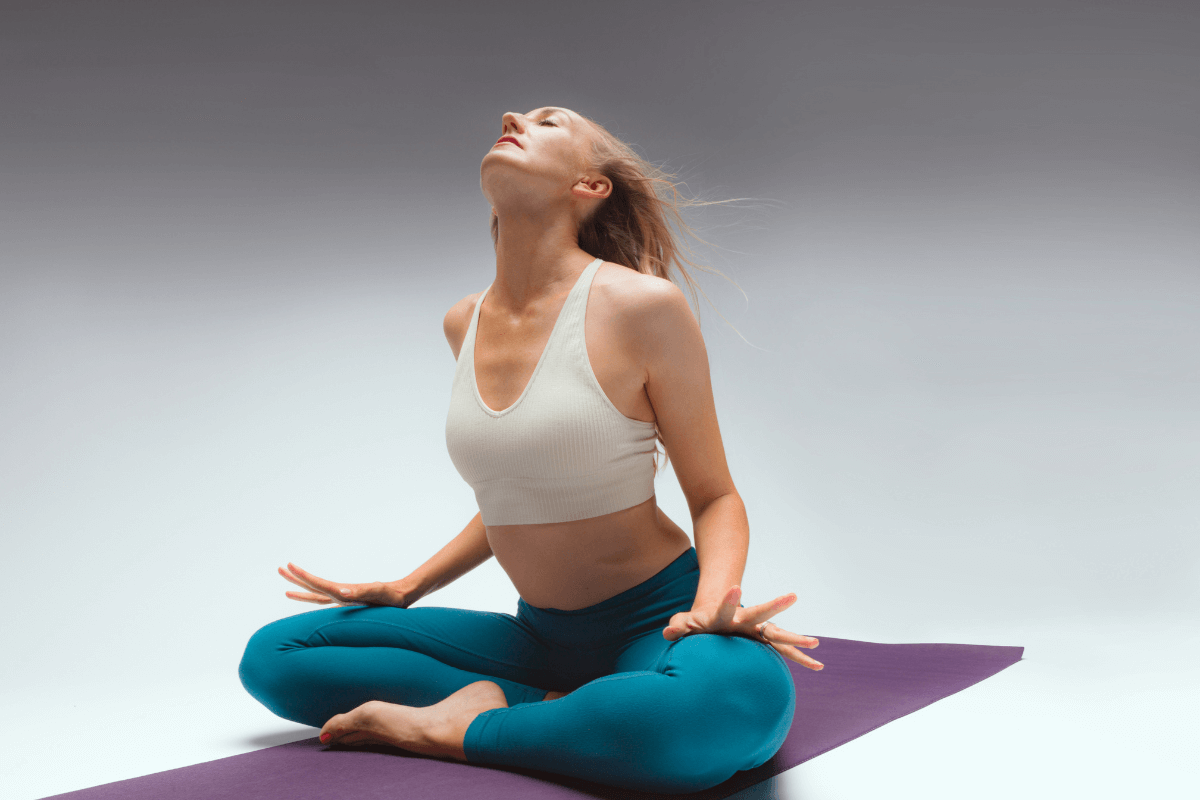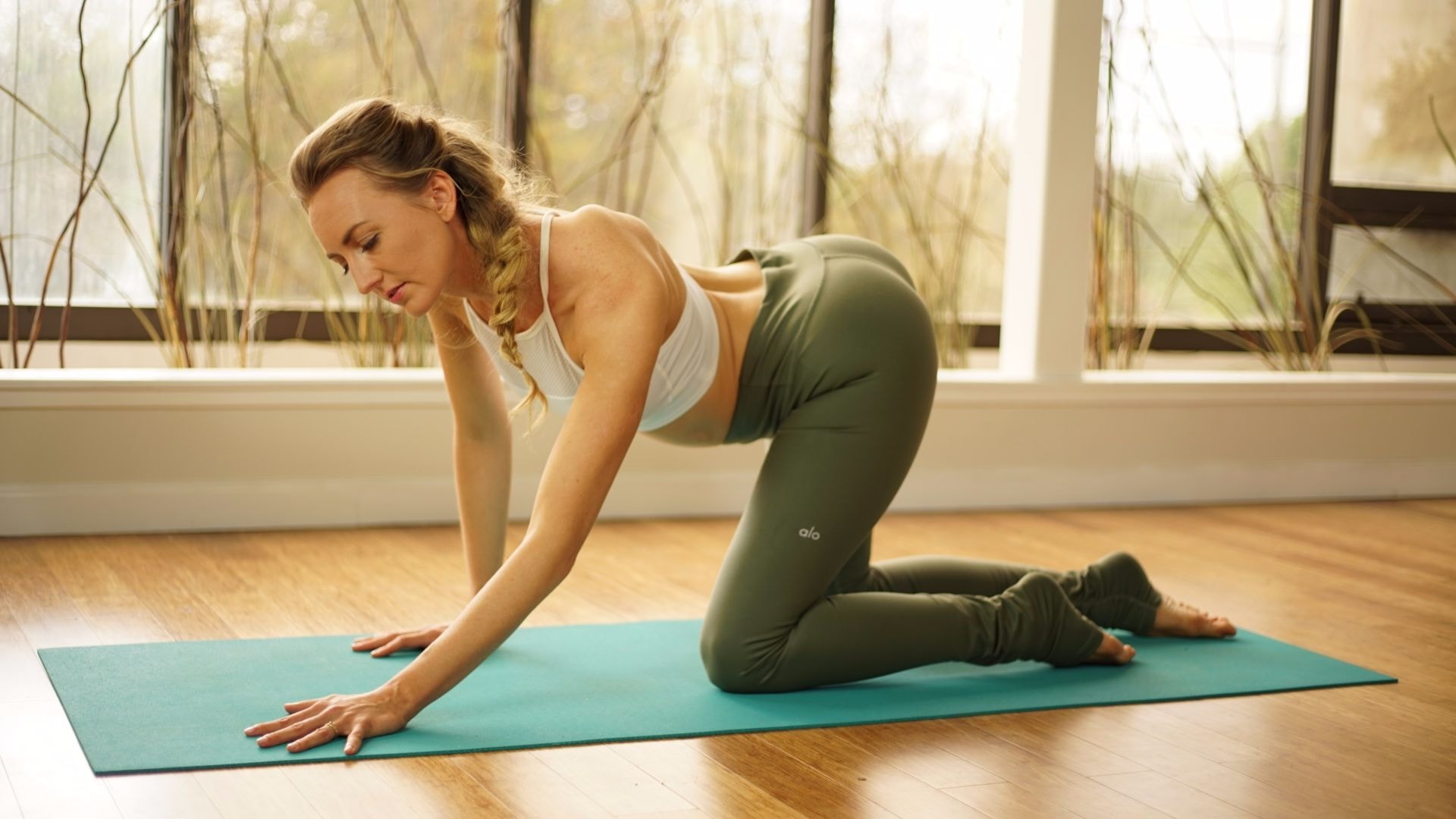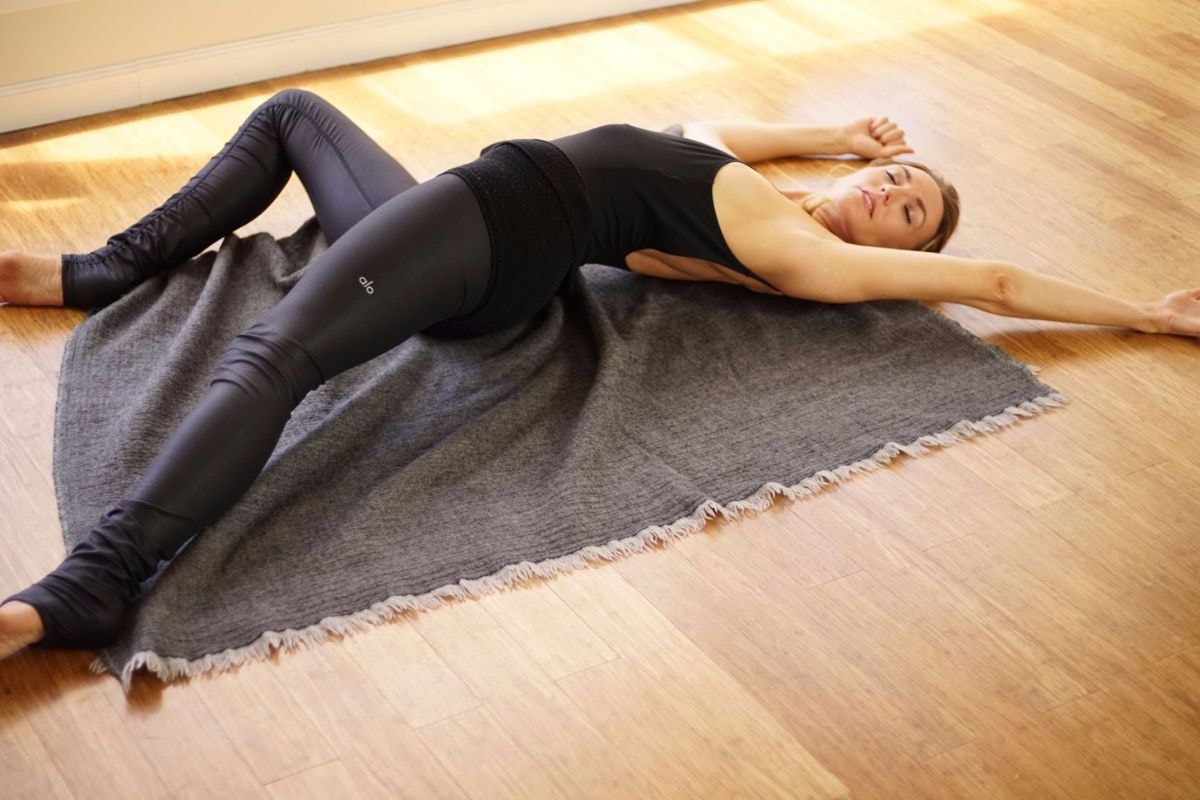I get it. So much of yoga is about stretching.
Whether you’re working out on or off the mat, your stretching routine can get old, fast. You may find yourself sick of doing the same poses and stretches, over and over again.
That’s why I want to introduce you to somatic stretching…
If you’re tired of the same old stretch routines and yearn for something deeper, this could be just your ticket to unlock a whole new level of flexibility and relaxation.
Imagine a stretching technique that doesn’t just target your muscles but also tunes into your body’s innate wisdom, helping you release tension you didn’t even know you were holding.
Somatic stretching does exactly that.
As a registered yoga teacher, I’ve seen firsthand how this approach can enhance not only flexibility but also body awareness, mindfulness, physical health, and overall health.
Whether you’re a seasoned yogi or someone just starting out who wants to learn somatic yoga for beginners, somatic stretching will help you reconnect with your body, listen to your inner experience, and honor your needs in a way that traditional stretching often overlooks.
If you’re ready to see what somatic stretching involves, then let’s take a look at some of these somatic movement techniques!
First, let’s start with the basics…
What Is Somatic Stretching?

Somatic stretching is a way to deepen your mind body connection by slowly lengthening your muscles letting your body’s innate intelligence lead the way. Somatic stretching aims to give you sensory feedback and raise your somatic awareness of muscle tension patterns while also encouraging relaxation and release through gentle, deliberate movements. All somatic practices and somatic therapy techniques focus on the mind body connection as a way to release unresolved emotional issues, reduce muscle tension, and lower stress.
Think of somatic stretching as a tonic for your nervous system, releasing tension through deep breaths and mindful movement. It’s especially helpful for anyone who has experienced trauma, which is most of us, in one form or another.
In fact, our bodies react to daily stress and trauma with specific muscle reflexes, leading to involuntary and habitual contractions or movements that cause stiffness and pain.
In my 200-Hour Yoga Teacher Training, this is what I call “habitual bracing patterns.” As these habitual patterns continue, you might experience mental health or physical symptoms, like chronic pain, a dysregulated nervous system, and even post traumatic stress disorder. Somatic movement helps release tension and all those patterns your body feels.
By tuning into and bringing awareness to your body’s sensations, you’ll begin to feel subtle shifts in tension and even enhance your proprioception—the body’s ability to sense its own position in space. This mindful approach not only helps prevent injuries by promoting balanced muscle activation but also fosters a profound sense of relaxation and presence during your practice.
All you need to start somatic stretching is a willingness to explore and curiosity about your internal experience.
Benefits Of Somatic Stretching

Now, you’re probably thinking, what can somatic exercise do for me? Do I need somatic training? Will it help with chronic pain? Will it release stress? Help with a neck release or certain muscles where I store tension?
The answer is yes to all of the above. Somatic stretching provides a wide range of benefits for both the mind and body. By incorporating somatic exercises into your practice, you can experience big shifts in muscle relaxation, posture alignment, body awareness, and overall stress levels.
Here are some of the specific benefits of somatic stretches with slow movement…
Reduces chronic muscle pain and tension
If you have a chronic condition, like back pain, you may find relief as your muscles learn to release and relax through targeted somatic exercises (Enck et al., 2017).
Improves posture
Do you have tech neck? Somatic stretching helps correct habitual slouching, leading to a more upright stance, better breathing, and less strain on the spine and joints. And you can even complete a neck release sitting comfortably.
Enhances body awareness and coordination
You might see improved performance and fewer injuries as you gain increased control over your movements (Smith et al., 2020). A somatic movement therapist works closely with patients on specific somatic stretches to help them not only optimize physical health, but for the mental benefits too (similar to Tai Chi).
Promotes relaxation and reduces stress
Mind body exercises like somatic stretching have been shown to reduce stress levels and offer stress relief by fostering relaxation and mindfulness (Smith et al., 2020). More research continues to be done on how somatic movement promotes reduces muscle tension and stress.
Increases ease of motion
Regular practice can lead to smoother, more fluid movements, making daily activities more comfortable and efficient. When you stretch slowly, you improve your range of motion, all while you release built up tension.
These are just a few of the benefits of doing a somatic stretching routine. Here are some of the other positive effects you’ll see in your life:
- Improved Body Awareness
- Enhanced Flexibility and Mobility
- Better Mind-Body Connection
- Increased Relaxation
- More Emotional Release
- Enhanced Breath Awareness
- Self-Compassion
- Trauma Healing
- Improved Body Function
- Better Sleep
- Better Energy Flow
- Feeling More Empowered
Incorporating somatic stretching into your daily routine can lead to a more balanced, pain-free, and aware body and mind.
Experience My Somatic Yoga Workshop (usually $67) FREE!👇

How to Make a Stretch Somatic
Before I share my favorite somatic stretching techniques with you, I want to give you some tips on how to practice somatic stretching…
- Set an intention before beginning your practice, ensuring alignment with your emotional state.
- Integrate touch as a soothing mechanism for the nervous system; for instance, stroke your thighs, your arms, etc.
- Embrace spiraling motions to engage hips, wrists, ankles, and gently with your neck, leading with the chin.
- Alternate between clenching and unclenching fists, feet, and legs to heighten bodily awareness and sensation during stretches.
- Prioritize pleasure-driven movements, focusing on expanding and softening.
- Incorporate undulating motions to mimic fluid, oceanic movement patterns.
- Sing, chant, or even growl, to aid your emotional release and energy discharge.
- Shake it out! Shake your arms, limbs, your body.
Use these methods when you try out some of my favorite somatic stretches…
My Favorite Somatic Stretches

Here are some of my favorite somatic stretches that I highly recommend incorporating into your routine. These somatic exercises combine grounding exercises with gentle movement to help you boost your mind body connection and mental health through somatic movement.
I like to describe somatic movement as a massage for my insides – including my brain. You don’t have to master each somatic stretch or make sure you’re using the right foot, the right arm, or the right knee. Forget all the yoga alliance rules you’ve learned about “proper alignment”—and instead, trust your body.
Stay in each stretch for a few breaths and if you feel any physical pain, back off. Switch to the opposite side when you feel like it or try out other forms. Your body knows what’s best for your well being, so allow your movement to come from within.
Child’s Pose
Begin by kneeling on the floor, then sit back on your heels and lean forward, stretching your arms and slowly lower your torso towards the ground. This pose gently stretches the back and hips while promoting relaxation and grounding. This somatic movement is not about physical activity, but about releasing tension. Move to the left side towards your left arm, then shift over to your right. Let your body gyrate and move as it wants to.
Cat-Cow Stretch
This movement is one of my all-time favorite examples of somatic exercises because you have so much freedom to practice somatic movement. In fact, this one should be a part of all somatic therapy.
Start on your hands and knees with a neutral spine. Inhale as you arch your back (cow pose), then exhale as you round it (cat pose). Now let your body rotate, then switch from circling from the left side to the right. This movement-based exercise helps to release tension in the spine and improve flexibility.
Pelvic Tilts
If there’s any somatic movement I recommend for women in particular, it’s this one. Pelvic tilts are highly beneficial as they strengthen core pelvic muscles, alleviate lower back pain, and enhance pelvic floor health, which is crucial for bladder control and sexual health. These somatic movement exercises also help you connect more deeply with their pelvic region.
Lie on your back with your knees bent and feet flat on the floor. Gently tilt your pelvis up towards your ribcage as you exhale, then release back to neutral as you inhale. Let your body express whatever movement comes naturally.
Supine Twist

My body loves a good supine twist. Remember to take it slow, and you’re not meant to push your body. Simply get into position and slowly breathe. That’s it!
Lie on your back with your arms outstretched and knees bent. Let your knees fall to one side while keeping your shoulders on the ground, then switch sides. When twisting to your left side, let your left ear touch the floor and vice versa. This twist helps to release tension in the spine and improve the overall mobility of your body.
Standing Forward Bend
My favorite standing somatic movement happens on your feet. This is a great, full body stretch.
Stand with your feet hip-width apart and slowly fold forward, allowing your upper body to hang. This stretch targets the hamstrings and lower back, so use blocks if you need support. Move side to side, swing your arms, follow what your body wants.
Seated Spinal Roll
There’s nothing your body loves more than a good spine stretch.
Sit with your legs extended and back straight. Slowly roll down one vertebra at a time until you’re lying flat, then reverse the movement to sit back up. This exercise enhances spinal mobility and coordination.
Legs Up the Wall
If you have two minutes and you’re near a wall, you can do this one. I even like to do it in bed.
Sit next to a wall and lie back while swinging your legs up to rest against the wall. This restorative pose helps to relieve tension in the legs and lower back, promotes relaxation, and can even reduce swelling. Bend your knees, widen your legs, and do what feels best for your body.
Happy Baby Pose
Last but not least, this is like the reverse of Cat/Cow, offering a massage to your spine from the ground.
Lie on your back and bring your knees towards your chest, grabbing the outside edges of your feet with your hands. Gently rock side to side. Move however feels best to you. This pose opens the hips, stretches the inner thighs, and provides a playful, grounding sensation.
Final Thoughts

Through gentle, intuitive movements and mindful breathing, somatic stretching can help you access deeper states of relaxation, regulate your nervous system, and cultivate a sense of inner peace.
By incorporating somatic stretching into your daily routine, you create a solid foundation for a balanced and connected life. This practice helps you stay grounded while promoting a deep connection to your inner self.
As you continue on this path, you’ll find greater clarity, wisdom, and a profound sense of peace that comes from living in alignment with your true nature.
Next Steps
If you’re ready to deepen your practice of somatic stretching, join my Embodied Yoga Workshop. I’ll show you practical tools to enhance your daily life and relationships through intuitive movement and somatic awareness.
Or if you’re ready to learn more about somatic techniques and how to teach somatic yoga, sign up for my 200-Hour Online Yoga Teacher Training. This comprehensive training will equip you with practical tools and insights to enhance your practice and effectively guide others on their somatic yoga journey.

FREE Embodied Yoga Workshop (usually $67) Somatic Techniques & Cord Cutting Ritual

YOU MIGHT ALSO LIKE
- How Somatic Shaking Can Release Tension and Reset Your Nervous System
- Discover Somatic Pilates: Enhance Your Body Awareness and Flexibility
- Kundalini for Feminine Energy: Ignite Your Creative Power and Passion
- 6 Effective Somatic Yoga for Neck and Shoulders
- How to Teach Somatic Yoga: A Practical Guide for Instructors
- The Best Somatic Exercises for Grief: Find Healing Through Movement
- The Best Somatic Exercises for Anger Management and Emotional Release
- How to Teach Somatic Yoga to Beginners
- Best Somatic Yoga Poses for Emotional Release and Healing
- The Rich History of Somatic Yoga: From Origins to Modern Practices
- Somatic Yoga for Stress: Effective Techniques to Find Calm and Relief
- The Perfect Yoga Practice For Your Menstrual Cycle Energy Levels
- Enhancing Your Practice: The Benefits of Yoga and Nature Connection
- Gentle Somatic Yoga for Back Pain: Relief and Prevention Techniques
- How Somatic Yoga for Anxiety Can Help You Find Calm and Balance














